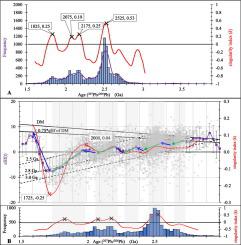Earth-Science Reviews ( IF 12.1 ) Pub Date : 2023-03-11 , DOI: 10.1016/j.earscirev.2023.104372 Zhen-Jie Zhang , Timothy Kusky , Min Gao , Qiu-Ming Cheng

|
The formation mechanism of the North China Craton (NCC) is controversial, with one model (Model 1) suggesting that it was formed by progressive accretion of arcs by generally westward subduction in the Archean, then progressive outboard accretion via eastward subduction culminating in a N-S collision when the composite craton was amalgamated with the Columbia Supercontinent. In contrast, another popular model (Model 2) suggests that various coherent blocks collided in the Paleoproterozoic, forming a network of Paleoproterozoic (1.9–1.85 Ga) orogens with high-grade metamorphism defining the belts. Here, we test these contrasting models, using big data analysis of detrital zircons from well-exposed Precambrian massifs in the Mesozoic Taihang Mountains of the central NCC (CNCC), that cut across the boundaries of the sutures and tectonic zones proposed by the different models. The zircons record the magmatic and metamorphic history of the basement, and we use big data and spatio-temporal analysis techniques to test the along-strike variations in ages of magmatism and metamorphism, providing quantitative constraints as tests of the models.
Simple age peaks can not represent the real magmatic intensity owing to preferential preservation. However, singularity indices, the time-varied indicators of power-law modeling, can characterize the spatiotemporal heterogeneity of mass distribution under unsteady trends. They can provide more stable and reliable time-series distributions. Our results show a multi-stage ladder-shaped evolutionary trend of εHf(t) values for igneous-originated detrital zircon during 3.7 to 1.5 Ga, representing progressive amalgamation of the craton, consistent with Model 1. The detrital zircon age singularity index series revealed three high-flux magmatic and two metamorphic events. The first magmatism and metamorphism occurred over almost the entire CNCC but was concentrated at its eastern margin, with an age peak at ca. 2.5 Ga. This event may have been caused by the arc–continent accretion along the eastern margin of the CNCC and the western margin of the Eastern Block as proposed by Model 1. The second magmatism developed primarily in the central CNCC, in the absence of contemporaneous metamorphism at ca. 2.15 Ga. This event reveals a local lithospheric extension that is probably a retroarc event from the convergent margin on the northern margin of the craton, as this event is recorded elsewhere in the NCC outside of the CNCC. The final magmatic event, with a violent fluctuation in the range of εHf(t) values and contemporaneous metamorphism, is almost absent in the central CNCC (only 6% data points) but spread throughout the northern and southern CNCC at ca. 1.85 Ga, and represents collisional assembly of the NCC with other outboard continental blocks representing the Columbia Supercontinent, also consistent with Model 1, but inconsistent with Model 2 that invokes the 1.85 collision to be along the full length of the CNCC, not only at its northern or southern margins. The westward migration of magmatic activity and high εHf(t) value centers after 2.5 Ga indicate the occurrence of a new east-dipping subduction system after collision of the Central (Wutai/Fuping) arc, and progressive migration of the orogenic front in the Paleoproterozoic.
中文翻译:

碎屑锆石U-Pb年代学和Hf同位素大数据集时空分析——华北克拉通前寒武纪演化构造模式检验
华北克拉通 (NCC) 的形成机制是有争议的,一个模型(模型 1)表明它是由太古宙中普遍向西俯冲的弧形渐进增生,然后通过向东俯冲在 NS 中达到顶峰的渐进外侧增生形成的当复合克拉通与哥伦比亚超大陆合并时发生碰撞。相比之下,另一个流行的模型(模型 2)表明,各种连贯的块体在古元古代碰撞,形成了古元古代(1.9-1.85 Ga)造山带的网络,其中高级变质作用定义了带。在这里,我们测试了这些对比模型,使用来自华北克拉通中部(CNCC)中生代太行山中暴露良好的前寒武纪地块的碎屑锆石的大数据分析,跨越不同模型提出的缝合线和构造带的边界。锆石记录了基底的岩浆和变质历史,我们利用大数据和时空分析技术测试了岩浆作用和变质作用年龄的沿走向变化,为模型的检验提供了定量约束。
由于优先保存,简单的年龄峰不能代表真实的岩浆强度。然而,奇点指数,即幂律模型的时变指标,可以表征不稳定趋势下质量分布的时空异质性。它们可以提供更稳定可靠的时间序列分布。我们的结果显示了 ε Hf ( t) 3.7 至 1.5 Ga 期间火成岩碎屑锆石的值,代表克拉通的逐渐合并,与模型 1 一致。碎屑锆石年龄奇异性指数系列揭示了三个高通量岩浆和两个变质事件。第一次岩浆作用和变质作用几乎发生在整个 CNCC,但集中在其东部边缘,年龄峰值约为 2.5 Ga 该事件可能是模型 1 提出的 CNCC 东缘和东陆块西缘的弧-陆增生造成的。第二次岩浆作用主要发育在 CNCC 中部,约同期变质作用。2.15 Ga。该事件揭示了局部岩石圈延伸,这可能是克拉通北缘汇聚边缘的弧后事件,因为此事件记录在 CNCC 以外的 NCC 其他地方。最终的岩浆事件,在ε范围内剧烈波动Hf ( t ) 值和同期变质作用在 CNCC 中部几乎不存在(只有 6% 的数据点),但分布在 CNCC 的北部和南部约 1.85 Ga,代表 NCC 与代表哥伦比亚超大陆的其他外侧大陆块的碰撞组合,也与模型 1 一致,但与模型 2 不一致,模型 2 调用 1.85 碰撞沿着 CNCC 的全长,不仅在其北部或南部边缘。2.5 Ga后岩浆活动西移和高εHf(t)值中心表明中央(五台/富平)弧碰撞后新的东倾俯冲体系的出现,以及古元古代造山前缘的逐步迁移.


























 京公网安备 11010802027423号
京公网安备 11010802027423号